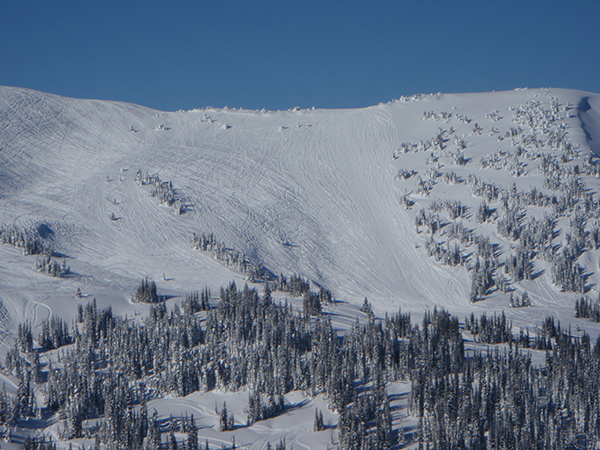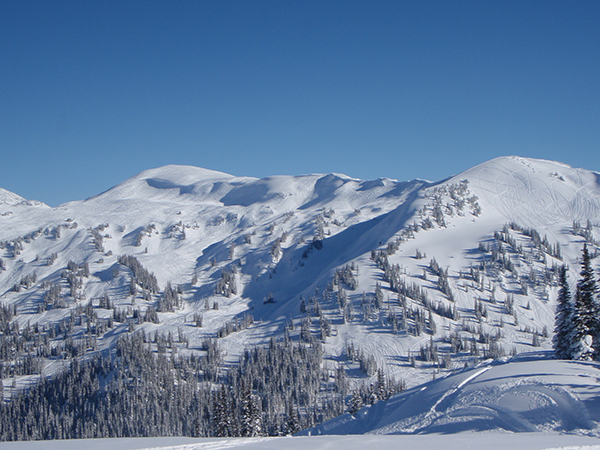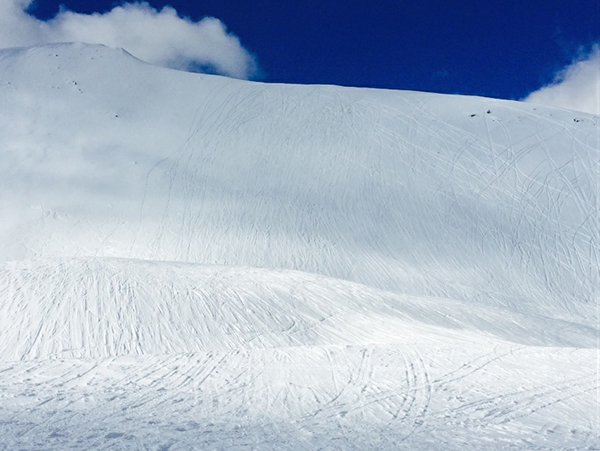From volume 109, spring 2015
By Curtis Pawliuk

ALLEN CREEK RIDING AREA IN LOCATION KNOWN AS OLD HILLCLMB, SHOWING TYPICAL USE. NOTE OPTIONS FOR STUDY IN MIDDLE OF PHOTO // CURTIS PAWLIUK
IS CONSISTENT AND WIDESPREAD USE of more popular managed snowmobile areas creating a growing and dangerous sense of inflated experience and over confidence in mountain terrain?
British Columbia is home to approximately 85 snowmobile areas that are classified as managed. These managed areas are operated and overseen by local organizations and clubs in partnership with Recreation Sites and Trails BC, a department of the Ministry of Forest Lands and Natural Resource Operations.
Outside pressures like the Species at Risk Act and conflicts over land use are ultimately limiting motorized (snowmobile) access to many areas of the open backcountry. As access to BC’s backcountry becomes more restricted, the snowmobiling public is more likely to utilize these managed recreational snowmobile areas.
The word managed may be a bit misleading. The typical agreement has local clubs or organizations maintaining a groomed trail that may or may not lead to an alpine shelter as its final destination. Many of these access trails are mechanically groomed and are access points to a variety of areas, including treeline and alpine terrain. These “play” areas can see very heavy use by snowmobilers of all ages and riding abilities although there is no form of management beyond the end of the access trail.
Naturally some of these areas are quite a bit busier than others and some can see hundreds of users over any given weekend. Regular winter season use of these areas can begin as early as the beginning of November and continue on well into May.
One of the areas in BC I am most experienced with is Allen Creek. This is very large area that is bound on all sides by legislated wildlife closures, leaving boundaries that are quite clear. At times, especially during periods of extended drought, fresh lines can be difficult to find. Allen Creek is likely one of the most frequented managed snowmobile areas in Western Canada. The area holds a large mix of accessible terrain with ATES classifications ranging from non-avalanche terrain, simple, challenging and complex areas. All of the managed areas around BC have been ATES mapped through multi-year projects between Avalanche Canada and Recreation Sites and Trails BC.
Allen Creek holds the same features as any high alpine mountain environment, and after a busy week it is not uncommon to see 80% of the terrain within the area’s relatively large boundaries resembling a parking lot, with every morsel of snow absolutely steam rolled. This phenomenon begins at the start of the snowy season (generally mid-November) and typically ends in late April or early May depending on the year. Compaction of the annual snowpack within the area’s boundaries is extensive. During times of infrequent snowfall little terrain is left untouched. This includes slopes of 45-50 degrees or steeper, including concavities, convexities, creek beds, gullies, and all aspects and elevations at treeline and above.
Over the last eight seasons of frequenting these areas multiple times per week and having to regularly search for that elusive unaffected location for stability tests and snow profiles, I have spent a significant amount of time thinking about the effects of compaction in these popular public snowmobiling areas. Extensive snowmobile compaction not only has relevance to stability and avalanche hazard but it also exerts an influence on the riders in the form of human factors such as familiarity and scarcity.

ALLEN CREEK, LOCATION KNOWN AS SUPERBOWL. NOTICE THE HEAVY USE IN CHALLENGING TERRAIN // CURTIS PAWLIUK
As riders become more skilled and push the technical limits of their sport, be it strictly snowmobiling or snowmobile assisted ski touring, it has become increasingly difficult to find a location within Allen Creek (and many other managed snowmobile areas) that hasn’t met a season’s worth of sled or ski traffic. When I am able to find an untouched location, I begin to wonder—is it truly representative of the overall snowpack condition within the region?
As an area representative, acting as the general manager and avalanche technician for the local snowmobile organization and operating a snowmobile backcountry guiding and avalanche education business, I try to regularly convey important local information relating to the snowpack and riding conditions within these managed areas to our users via email lists, social media and general correspondence.
I often think about the effects of compaction within these popular areas. Managed snowmobile areas throughout BC receive hundreds if not thousands of user days per weekend, and many thousands per season. This does have a profound effect on the snowpack and the avalanche hazard within these regions; it is likely a contributing factor to why we don’t see more incidents involving snowmobilers given the nature of the terrain they travel in. The majority of the snowpack within managed areas is simply compacted to such an extent that it behaves more like a modified snowpack than it does like the less-frequented backcountry.
Much of the public rides in or travels through complex terrain. On any given winter day in BC, there are nonguided, recreational snowmobilers with unknown levels of training moving through large expanses of alpine terrain. Thankfully there are minimal reported avalanches, whether simple involvements or fatal accidents.
A few key questions come to mind regarding these managed public areas, the snowmobile use they see and the compaction that results:
• Does the extensive compaction in these heavily used managed areas result in non-event feedback, which is potentially developing a growing and dangerous sense of inflated experience and over-confidence in mountain terrain?
• Should this change our messaging to riders within specific regions?
• As professionals, how do we start to understand the role of compaction in these areas?
• When do we address this growing and likely inaccurate sense of self-confidence and complacency?
• If we do not openly discuss the idea of compaction within these areas and its potential benefits and dangers, are we withholding possibly life saving information?
• Should we communicate the effects of compaction in the public bulletin?
My personal feeling to many of these questions is yes, but how?
From my experience over the last eight years of observations, the heavily used managed recreational areas are providing a safer experience, with reduced avalanche hazard due to mechanical compaction. My feeling is that we address the idea in greater fashion. We can make our public avalanche safety programs stronger by recognizing and addressing the extensive compaction that regularly occurs at managed snowmobile areas. The question looms: how is this message most effectively delivered?
Not everyone chooses to utilize managed areas. Recreational users may seek out more elusive and secluded areas where regular compaction over a very large common area is no longer the case. This decision to push beyond compacted areas may come with time and/or the individual’s progression and experience level in the activity, or simply from a desire to find fresh tracks in times of low snowfall. They could also simply be following a blind desire to go off the beaten path even though their experience level may not be there. There are many human factors that influence us all, especially newcomers to mountainous terrain.

CLEMINA CREEK GOAT RIDGE BOWL. HEAVILY USED, PLANAR SLOPE REACHING UPWARDS OF 45°. NOTE LEFT OF PHOTO, NOT AS COMPACTED AND IS A REGULAR PERFORMER CAUSING A FATAL AVALANCHE IN THE 2013/2014 SEASON // CURTIS PAWLIUK
Due to their intense use, managed areas may be best looked at and discussed as a stepping stone to gaining experience with mountain terrain—to increase personal snowpack assessment and general backcountry skills before moving into large, less compacted snowpacks which arguably present a greater hazard.
As instructors, mentors and educators, when should compaction in managed snowmobile areas come into the conversation? Currently, I have not found anything addressing the idea that popular managed recreation areas may be safer due to the compaction phenomenon. There are many points that could be argued and all need a focused attention, though I have seen the benefits of compaction within these areas for many years.
I believe our lessons and correspondence to the recreational snowmobile community need to address a stronger message on the impacts of compaction in heavily frequented areas. That message may simply be that on a high hazard day, a managed area may provide a rider with a safer experience than the untouched and raw backcountry. However, I’m left with the question of how could we effectively convey this message without causing more harm than good?









